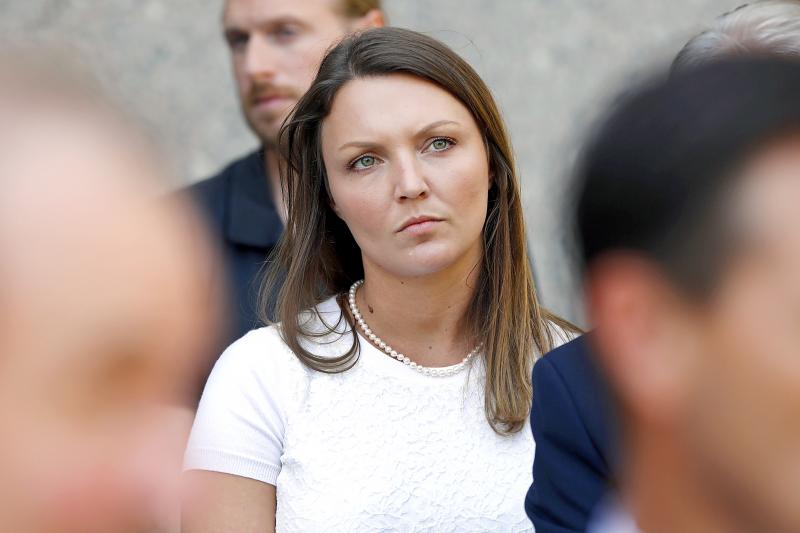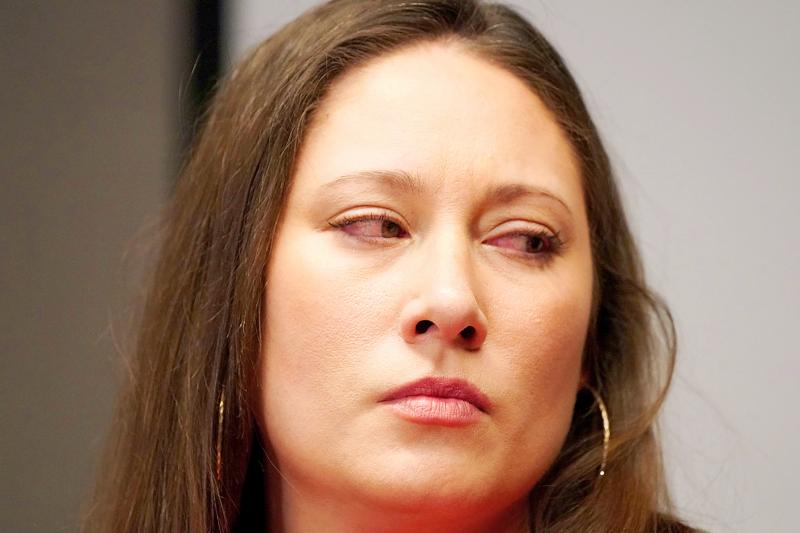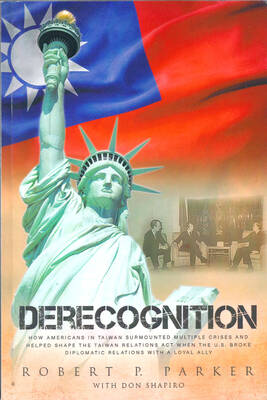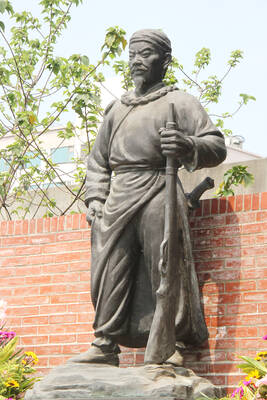It’s difficult to watch Jeffrey Epstein: Filthy Rich, a four-hour Netflix series on the now-deceased convicted sex offender without a choking sense of outrage. How many girls had to suffer to get attention?
How perversely twisted is the American justice system that a Gatsby-esque billionaire, friends with such powerful figures as Bill Clinton , Prince Andrew and Donald Trump, a longstanding donor to Harvard and MIT, could buy his way out of an almost certain life sentence for child sex abuse and trafficking?
Filthy Rich arrives, of course, less than a year after Epstein, 66, died, officially by suicide, in a New York jail last August.

Photo: Reuters
“There’s no justice in this,” Shawna Rivera, speaking publicly for the first time about Epstein’s alleged abuse starting when she was 14, says in the final episode. “There was just so much more to be said that will never be said.”
There is, however, much to be learned from the sordid, winding, thwarted path to Epstein’s eventual arrest on sex trafficking charges in July last year. Filthy Rich doesn’t so much break new ground as synthesize the abundance of information with the visceral impact of first-person testimony on Epstein’s crimes — stories of predation, self-doubt and shame by numerous survivors betrayed by the justice system supposed to protect them. Epstein’s decades-long legal saga is “the biggest example I’ve ever seen of somebody using their money and influence to thwart reporting on the subject and to work out an outrageous deal,” Joe Berlinger, an executive producer, told the Guardian.
Production on Filthy Rich began before Epstein became a household name — before his death, before his shock arrest, before a 2018 Pulitzer-winning investigation by the Miami Times-Herald into the sweetheart plea deal negotiated by federal prosecutors to keep Epstein out of prison.

Photo: AP
“The level of incompetence and back-door dealing that allowed him to get off — no one on this production thought he would ever be arrested during the making of the show,” said Berlinger, who first began work on an Epstein project in spring 2018, after he received a copy of mystery novelist James Patterson’s 2016 true crime book on the reclusive billionaire (and neighbor in Palm Beach).
The book “infuriated me,” Berlinger said, especially since, in 2018, “people were afraid to tell this story.”
Convincing women to speak on the record “was hard,” director Lisa Bryant said.

Photo: Reuters
“Some people wouldn’t talk at all, some numbers were wrong, some decided they just weren’t ever going to talk, for various reasons. Some hadn’t even told their parents about it.”
The case of Epstein was never a he-said, she-said situation; to quote retired Palm Beach police chief Michael Reiter in the Herald’s original story: “This was 50-something ‘shes’ and one ‘he’ — and the ‘shes’ all basically told the same story.”
But Epstein’s intimidation factor was strong, and many of the survivors, their justice thwarted by the plea deal and Epstein’s subsequent immunity, had moved on with their lives.
“Yes, there was a pattern that he had, but each person’s experience with that and how they handled it is different,” said Bryant. “This is their story to tell, their narrative. We wanted this to be told through their eyes.”
The series revolves around the various experiences of the survivors, dating back to at least 1996, when the painter Maria Farmer and her teenage sister, Annie, contacted the FBI to allege molestation by Epstein and his ex-girlfriend Ghislaine Maxwell. It went nowhere.
Years later, in 2005, Palm Beach police launched an investigation into an alleged sex ring run out of Epstein’s beachside mansion, in which Epstein and Maxwell allegedly coerced high-school girls — most of them around 14, in vulnerable circumstances and needing money — into sex acts under the pretense of a “massage” for US$200. Maxwell has denied any involvement.
The alleged crimes expanded even further, as favorites were allegedly trafficked to rich and powerful friends for parties at Epstein’s US$77 million Upper East Side mansion in New York, at a London townhouse, and on Epstein’s private island in the Caribbean.
Some survivors featured in the series are speaking on camera for the first time; others, such as Virginia Giuffre, have been advocating for justice for years. Giuffre alleges in and out of the documentary that she was forced to have sex with Prince Andrew, who has denied the allegations and queried the veracity of a photo that exists of his arm around her aged 18, with a smiling Maxwell in the background.
Given witness testimony in the series by a former Epstein employee who alleges he saw the prince engaged in poolside “foreplay” with a topless Giuffre on Epstein’s island, Andrew’s defense and lack of cooperation with prosecutors reads even more shabbily here. Andrew says he has “no recollection” of meeting Giuffre.
The show stokes justifiable outrage through each survivor’s account, retracing how the Palm Beach police department’s investigation bumped up to the FBI, and was then derailed by a “non-prosecution agreement” the Herald called “the deal of a lifetime.”
Signed in 2008, the deal — brokered by state attorney and later Trump labor secretary Alex Acosta and Epstein’s all-star team of lawyers, including OJ Simpson defender Alan Dershowitz (the only Epstein acolyte to attempt a defense in the series) — was controversially sealed and kept private from the accusers. It offered Epstein and named and unnamed co-conspirators immunity from federal criminal charges; instead, he plead guilty to two prostitution charges in state court, and served 11 of 13 months in Palm Beach jail, out six days a week on “work release”.
“He was still seeing girls, he was still making money, he was still conducting business — I mean, it’s just outrageous,” said Berlinger of Epstein’s “incarceration.”
Epstein’s elusion of justice for another decade demonstrated how the American criminal justice system “was built for money and power and political gain,” said Bryant. “And we see that over and over again in this case.”
The series also addresses, but does not endorse, conspiracy theories on the cause of Epstein’s death; the medical examiner ruled a suicide by hanging, though an outside expert hired by Epstein’s brother raised unsubstantiated doubts, citing an unusual neck fracture.
“I think it’s up for debate, and for people to look at the evidence both ways and make their own decisions,” said Bryant.
“There was nothing that we turned up that would definitively support the idea that he was murdered,” said Berlinger, “but we certainly felt [the theories] should be touched upon.” Personally, Berlinger said: “I do believe it was suicide.”
Epstein’s death denied survivors’ their true day in court, though several did speak at a posthumous hearing. There remains the possibility of prosecuting those linked to Epstein: perhaps Maxwell, whose whereabouts remain unknown and who recently sued Epstein’s estate — the fund supposed to compensate victims — for her legal fees.
“I firmly believe and hope that the survivors will get that money,” said Bryant, and that statute of limitations are reconsidered given greater understanding of childhood sexual trauma, the length and difficulty of processing enough to speak publicly.
For the survivors, said Berlinger, “the ultimate closure would be for everyone who enabled this sick lifestyle and everyone who enabled a wealthy white person with power and influence to have a different standard of justice to also be held to account.”

One of the biggest sore spots in Taiwan’s historical friendship with the US came in 1979 when US president Jimmy Carter broke off formal diplomatic relations with Taiwan’s Republic of China (ROC) government so that the US could establish relations with the People’s Republic of China (PRC). Taiwan’s derecognition came purely at China’s insistence, and the US took the deal. Retired American diplomat John Tkacik, who for almost decade surrounding that schism, from 1974 to 1982, worked in embassies in Taipei and Beijing and at the Taiwan Desk in Washington DC, recently argued in the Taipei Times that “President Carter’s derecognition

This year will go down in the history books. Taiwan faces enormous turmoil and uncertainty in the coming months. Which political parties are in a good position to handle big changes? All of the main parties are beset with challenges. Taking stock, this column examined the Taiwan People’s Party (TPP) (“Huang Kuo-chang’s choking the life out of the TPP,” May 28, page 12), the Democratic Progressive Party (DPP) (“Challenges amid choppy waters for the DPP,” June 14, page 12) and the Chinese Nationalist Party (KMT) (“KMT struggles to seize opportunities as ‘interesting times’ loom,” June 20, page 11). Times like these can

JUNE 30 to JULY 6 After being routed by the Japanese in the bloody battle of Baguashan (八卦山), Hsu Hsiang (徐驤) and a handful of surviving Hakka fighters sped toward Tainan. There, he would meet with Liu Yung-fu (劉永福), leader of the Black Flag Army who had assumed control of the resisting Republic of Formosa after its president and vice-president fled to China. Hsu, who had been fighting non-stop for over two months from Taoyuan to Changhua, was reportedly injured and exhausted. As the story goes, Liu advised that Hsu take shelter in China to recover and regroup, but Hsu steadfastly

You can tell a lot about a generation from the contents of their cool box: nowadays the barbecue ice bucket is likely to be filled with hard seltzers, non-alcoholic beers and fluorescent BuzzBallz — a particular favorite among Gen Z. Two decades ago, it was WKD, Bacardi Breezers and the odd Smirnoff Ice bobbing in a puddle of melted ice. And while nostalgia may have brought back some alcopops, the new wave of ready-to-drink (RTD) options look and taste noticeably different. It is not just the drinks that have changed, but drinking habits too, driven in part by more health-conscious consumers and